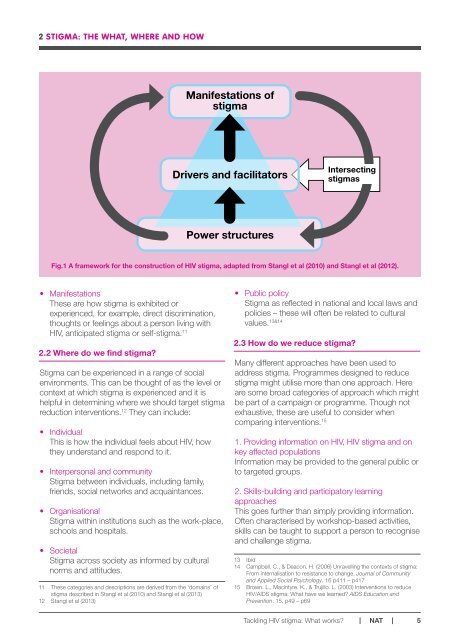Tackling HIV Stigma What works?
Jun_16_Tackling_HIV_Stigma
Jun_16_Tackling_HIV_Stigma
You also want an ePaper? Increase the reach of your titles
YUMPU automatically turns print PDFs into web optimized ePapers that Google loves.
2 STIGMA: THE WHAT, WHERE AND HOW<br />
Manifestations of<br />
stigma<br />
Drivers and facilitators<br />
Intersecting<br />
stigmas<br />
Power structures<br />
Fig.1 A framework for the construction of <strong>HIV</strong> stigma, adapted from Stangl et al (2010) and Stangl et al (2012).<br />
• Manifestations<br />
These are how stigma is exhibited or<br />
experienced, for example, direct discrimination,<br />
thoughts or feelings about a person living with<br />
<strong>HIV</strong>, anticipated stigma or self-stigma. 11<br />
2.2 Where do we find stigma?<br />
<strong>Stigma</strong> can be experienced in a range of social<br />
environments. This can be thought of as the level or<br />
context at which stigma is experienced and it is<br />
helpful in determining where we should target stigma<br />
reduction interventions. 12 They can include:<br />
• Individual<br />
This is how the individual feels about <strong>HIV</strong>, how<br />
they understand and respond to it.<br />
• Interpersonal and community<br />
<strong>Stigma</strong> between individuals, including family,<br />
friends, social net<strong>works</strong> and acquaintances.<br />
• Organisational<br />
<strong>Stigma</strong> within institutions such as the work-place,<br />
schools and hospitals.<br />
• Societal<br />
<strong>Stigma</strong> across society as informed by cultural<br />
norms and attitudes.<br />
11 These categories and descriptions are derived from the ‘domains’ of<br />
stigma described in Stangl et al (2010) and Stangl et al (2013)<br />
12 Stangl et al (2013)<br />
• Public policy<br />
<strong>Stigma</strong> as reflected in national and local laws and<br />
policies – these will often be related to cultural<br />
values. 13&14<br />
2.3 How do we reduce stigma?<br />
Many different approaches have been used to<br />
address stigma. Programmes designed to reduce<br />
stigma might utilise more than one approach. Here<br />
are some broad categories of approach which might<br />
be part of a campaign or programme. Though not<br />
exhaustive, these are useful to consider when<br />
comparing interventions. 15<br />
1. Providing information on <strong>HIV</strong>, <strong>HIV</strong> stigma and on<br />
key affected populations<br />
Information may be provided to the general public or<br />
to targeted groups.<br />
2. Skills-building and participatory learning<br />
approaches<br />
This goes further than simply providing information.<br />
Often characterised by <strong>works</strong>hop-based activities,<br />
skills can be taught to support a person to recognise<br />
and challenge stigma.<br />
13 Ibid<br />
14 Campbell. C., & Deacon. H. (2006) Unravelling the contexts of stigma:<br />
From internalisation to resistance to change. Journal of Community<br />
and Applied Social Psychology. 16 p411 – p417<br />
15 Brown. L., Macintyre. K., & Trujillo. L. (2003) Interventions to reduce<br />
<strong>HIV</strong>/AIDS stigma: <strong>What</strong> have we learned? AIDS Education and<br />
Prevention. 15, p49 – p69<br />
<strong>Tackling</strong> <strong>HIV</strong> stigma: <strong>What</strong> <strong>works</strong>? NAT 5


